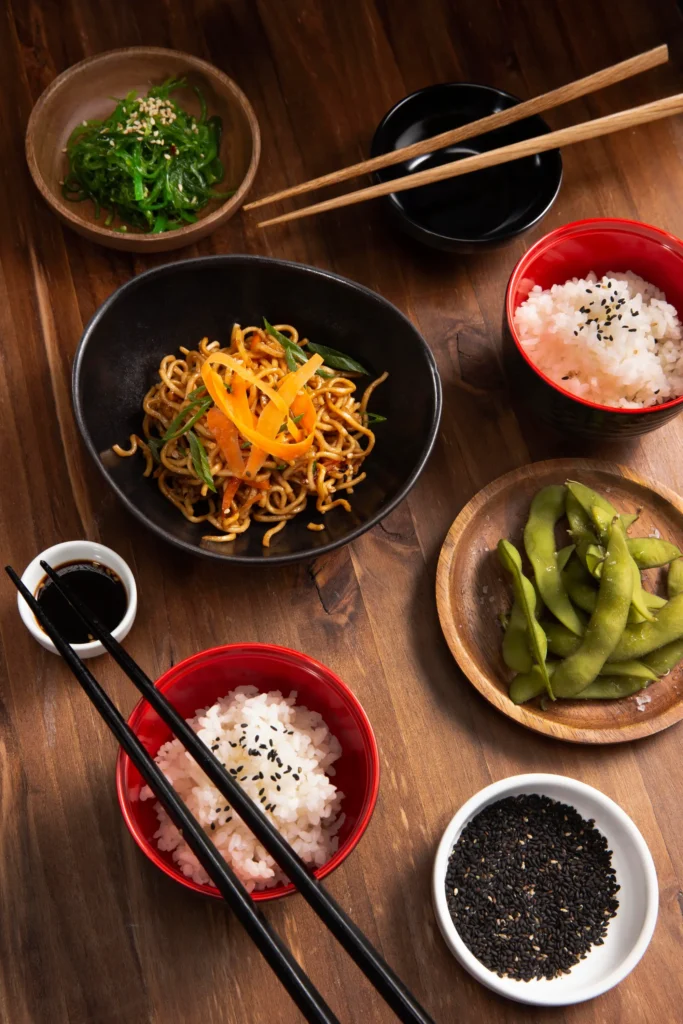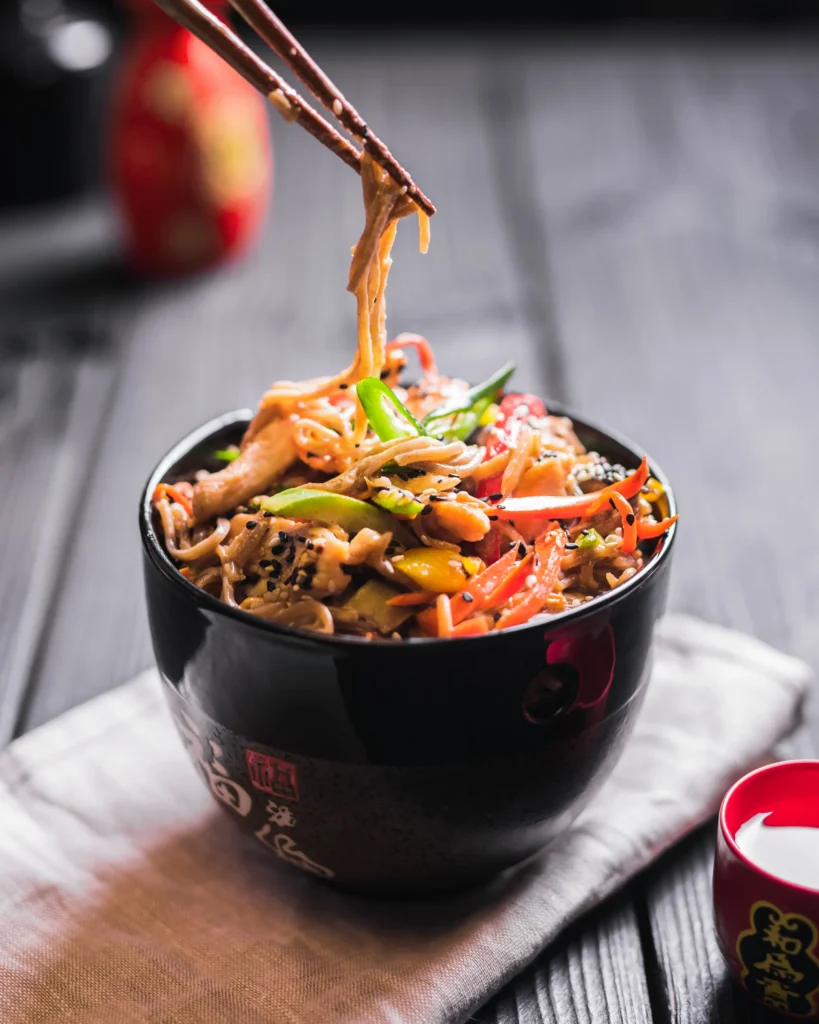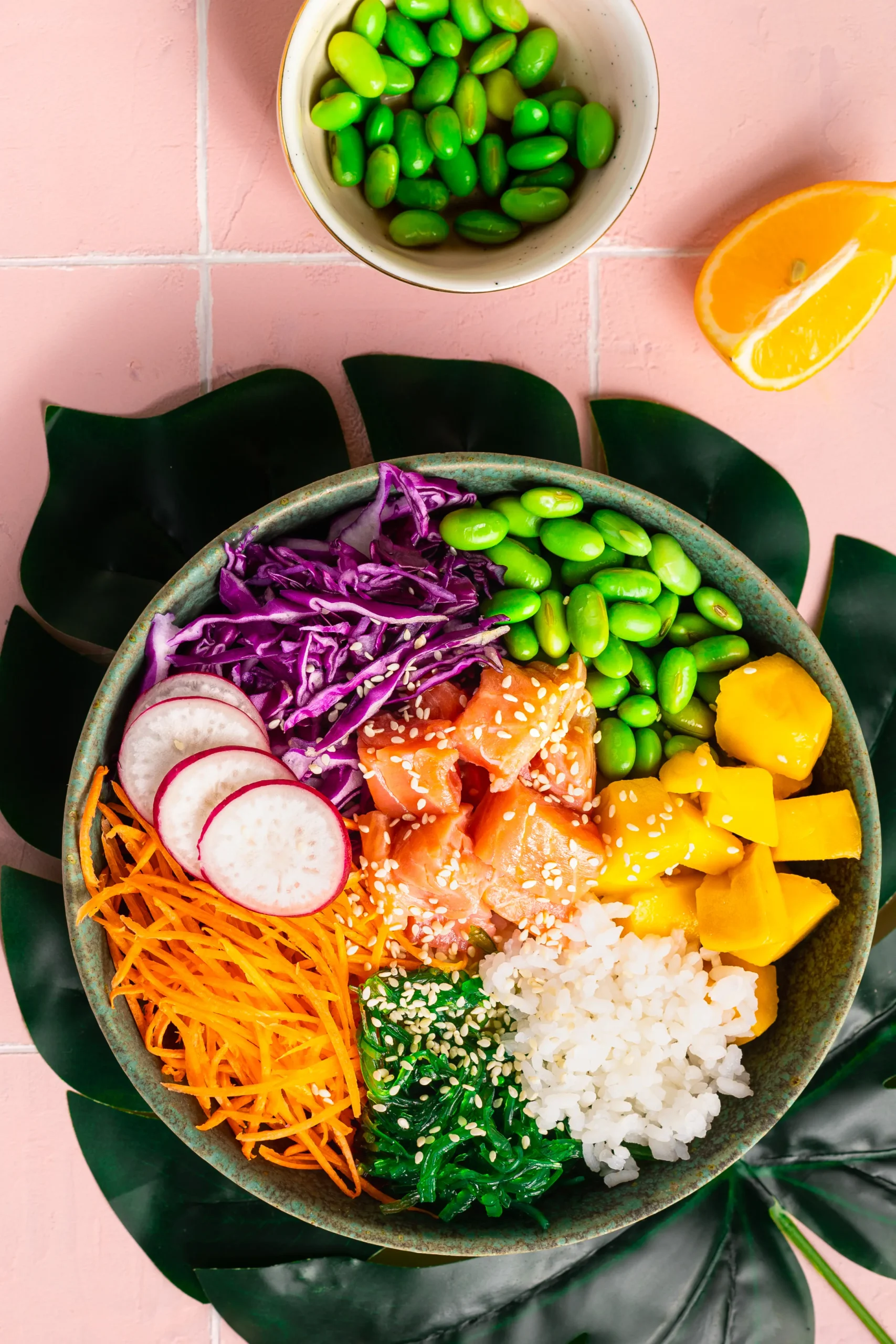Vegan Korean cuisine offers a vibrant exploration of flavors, textures, and nutritional benefits. This culinary tradition marries the richness of Korean flavors with the principles of veganism, creating dishes that are not only delicious but also deeply nourishing. Here, we delve into the essence of vegan Korean food, highlighting its key components and the unique qualities that make it a standout choice for food enthusiasts around the globe.
Key Components of Vegan Korean Cuisine
- Fresh Vegetables and Fruits: The backbone of any vegan Korean dish, fresh vegetables, and fruits, provide essential nutrients and flavors. From the crunch of kimchi to the softness of sautéed mushrooms, these ingredients form the colorful palette of Korean vegan cooking.
- Tofu and Plant-based Proteins: Tofu, along with other plant-based proteins, plays a crucial role in vegan Korean cuisine. These ingredients offer a versatile and satisfying alternative to meat, perfectly absorbing the bold spices and sauces typical of Korean dishes.
- Rich Spices and Fermented Sauces: The soul of Korean cuisine lies in its use of spices and fermented sauces. Gochujang (chili paste), doenjang (soybean paste), and ganjang (soy sauce) add depth and complexity, transforming simple ingredients into culinary masterpieces.
Nutritional Benefits
Vegan Korean food is not just a feast for the senses; it’s also a powerhouse of nutrition. This cuisine offers a balanced approach to eating, emphasizing whole foods, plant-based proteins, and fermented ingredients that support gut health. For those interested in the nutritional aspects of vegan Korean cuisine and how it fits into a balanced diet, exploring the principles of balanced nutrition can provide valuable insights. Unlocking the Secrets to Balanced Nutrition offers a deeper understanding of how vegan Korean dishes contribute to overall well-being.
Embracing Vegan Korean Cuisine
Embracing vegan Korean food means more than just enjoying delicious meals; it’s about appreciating the culture, history, and innovation behind each dish. Whether you’re a seasoned vegan or simply looking to diversify your culinary repertoire, Korean vegan cuisine offers a world of flavors waiting to be explored. From the spicy kick of kimchi to the comforting warmth of sundubu-jjigae (soft tofu stew), there’s a dish to satisfy every palate.
In conclusion, vegan Korean cuisine stands as a testament to the versatility and richness of plant-based cooking. It invites us to explore new flavors, embrace nutritional benefits, and celebrate the creativity inherent in vegan culinary practices.
Popular Vegan Korean Dishes
Exploring vegan Korean cuisine reveals a world where tradition meets plant-based innovation. Below, we delve into some of the most cherished vegan Korean dishes, highlighting the rich tapestry of tastes and textures that define this vibrant culinary landscape.

Vegan Bibimbap: A Colorful Medley
Bibimbap stands as a testament to the versatility and inherent beauty of vegan Korean food. This dish combines steamed rice with an assortment of sautéed vegetables, all brought together with the spicy warmth of gochujang.
- Key Ingredients: Steamed rice, spinach, shiitake mushrooms, carrots, zucchini, bean sprouts.
- Preparation: Vegetables are lightly sautéed and seasoned, then artfully arranged atop rice. A generous dollop of gochujang adds a fiery depth.
Kimchi: The Quintessential Korean Staple
Kimchi, with its tangy, spicy, and umami-rich profile, is indispensable in Korean cuisine. Vegan kimchi eschews traditional fish sauce for a blend of soy sauce and kelp powder, maintaining its authentic flavor.
- Key Ingredients: Napa cabbage, radish, spring onions, garlic, ginger, gochugaru.
- Vegan Adaptation: Substitute fish sauce with a mixture of soy sauce and kelp powder to achieve the umami depth.
Japchae: Sweet Potato Noodles and Vegetables
Japchae, a stir-fried noodle dish, perfectly exemplifies the harmony of sweet and savory flavors, with its glass noodles and crisp vegetables.
- Key Ingredients: Sweet potato noodles, spinach, carrots, onions, mushrooms.
- Preparation: Noodles are boiled and then tossed with vegetables in a savory sauce, highlighting the dish’s delightful texture contrast.
For those looking to explore more vegan Korean dishes, visiting Authentic Vegan Korean Recipes – Korean Bapsang offers a treasure trove of recipes.
Tteokbokki: Spicy Rice Cakes
Tteokbokki, a popular street food, is known for its chewy rice cakes smothered in a spicy, sweet sauce.
- Key Ingredients: Rice cakes, gochujang, sugar, garlic, green onions.
- Vegan Twist: Ensure the broth is vegetable-based and consider adding vegan fish cakes for authenticity.
Doenjang Jjigae: Soybean Paste Stew
This hearty stew is a staple in Korean households, rich in umami flavors from fermented soybean paste.
- Key Ingredients: Doenjang, tofu, mushrooms, onions, zucchini, garlic.
- Preparation: Simmer ingredients in a doenjang-based broth until tender and flavorful.
Sundubu-jjigae: Soft Tofu Stew
A comforting and spicy stew featuring soft tofu, sundubu-jjigae is a warming dish perfect for colder months.
- Key Ingredients: Soft tofu, kimchi, onions, mushrooms, gochugaru, vegetable broth.
- Preparation: Cook ingredients in a spicy broth, serving hot with rice.
Korean Vegan Pancakes (Pajeon)
Pajeon, or Korean pancakes, are a versatile dish that can be made with a variety of vegetable fillings.
- Key Ingredients: Wheat and rice flour, water, salt, green onions, and other vegetables.
- Preparation: Mix batter with vegetables and pan-fry until golden brown and crispy.
Exploring More Vegan Korean Food
The journey into vegan Korean cuisine doesn’t end with the dishes mentioned above. The culinary landscape is rich with plant-based options that are both traditional and innovative. From kongnamul (soybean sprouts) to gaji namul (seasoned eggplants), the variety of vegan dishes in Korean cuisine is vast and varied. Each dish offers a unique glimpse into the flavors and ingredients that define Korean cooking, providing endless inspiration for those looking to expand their vegan repertoire.
Incorporating Vegan Korean Dishes into Everyday Meals
Embracing vegan Korean dishes enriches your culinary repertoire, introducing you to a spectrum of flavors and ingredients that celebrate plant-based eating. Here are some tips for incorporating these dishes into your meals:
- Experiment and Adapt: Feel free to adjust recipes based on personal taste and ingredient availability.
- Flavor Balance: Aim for a balance of spicy, sweet, savory, and umami elements to capture the essence of Korean cuisine.
- Presentation: Korean meals often emphasize aesthetic appeal. Arrange your dishes thoughtfully to enhance the dining experience.
Vegan Korean cuisine is a vibrant exploration of flavors, textures, and culinary traditions. From the spicy kick of kimchi to the comforting embrace of bibimbap, these dishes offer a window into the heart of Korean culture, all while adhering to a plant-based lifestyle. By integrating these vegan adaptations into your cooking, you not only broaden your palate but also contribute to a more sustainable and health-conscious lifestyle.
FAQs on Vegan Korean Food
Vegan Korean cuisine offers a variety of flavors and dishes that cater to plant-based diets. Below are answers to some frequently asked questions about vegan Korean food, including insights into how vegans can navigate and enjoy Korean cuisine.

What Korean food can vegans eat?
Vegans can enjoy a wide range of Korean foods, many of which are naturally vegan or can be easily modified. Some popular dishes include:
- Kimchi: Traditionally made with fish sauce, but there are vegan versions using soy sauce or seaweed to achieve the umami flavor.
- Bibimbap: A mixed rice dish with vegetables, which can be made vegan by omitting egg and using a vegan-friendly sauce.
- Japchae: Stir-fried sweet potato noodles with vegetables, typically vegan.
- Tteokbokki: Spicy rice cakes, which can be vegan if made without fish cakes and with a vegan sauce.
Is South Korea vegan friendly?
South Korea is becoming increasingly vegan-friendly, with a growing number of restaurants offering vegan options. Major cities like Seoul have vegan and vegetarian restaurants that serve traditional Korean dishes made with plant-based ingredients. Additionally, many Buddhist temple foods are vegan, providing more options for plant-based diets.
Are Korean side dishes vegan?
Many Korean side dishes, known as banchan, can be vegan. Common vegan side dishes include:
- Namul: Seasoned vegetables, such as spinach or bean sprouts.
- Kongnamul: Soybean sprouts with sesame oil.
- Oi Muchim: Spicy cucumber salad.
- Moo Saengchae: Spicy radish salad.
However, it’s important to check for non-vegan ingredients like fish sauce or shrimp paste, which are sometimes used in seasoning.
Which Korean food is pure vegetarian?
Several Korean dishes are purely vegetarian and can be adapted for a vegan diet. These include:
- Bibimbap without egg.
- Japchae.
- Sundubu-jjigae (soft tofu stew) without seafood or meat.
- Vegetable pajeon (Korean pancake).
For those looking to explore vegan substitutes in Korean cooking, Vegan Substitutes in Korean Cooking – The Spruce Eats offers practical tips for veganizing Korean dishes.
Tips for Enjoying Vegan Korean Food
- Read Labels Carefully: When buying packaged foods or ingredients, always read labels to check for non-vegan items.
- Ask Questions: When dining out, don’t hesitate to ask about the ingredients used in dishes to ensure they meet your vegan diet.
- Explore Vegan Korean Recipes: With the rise of veganism, there are many resources online for vegan Korean recipes that maintain the authentic flavors of traditional dishes.
Vegan Korean food provides a rich culinary experience, with a variety of dishes that cater to plant-based diets. Whether you’re dining out or cooking at home, there are plenty of options to explore the flavors of Korea without compromising on your dietary preferences. As the vegan community grows, so does the availability of vegan Korean dishes, making it easier and more enjoyable to maintain a vegan lifestyle while indulging in the rich culinary heritage of Korea.
Conclusion
The exploration of vegan Korean cuisine offers a fascinating glimpse into the rich tapestry of flavors, textures, and culinary traditions that define Korea’s food culture. Embracing veganism within this context not only highlights the adaptability and creativity inherent in Korean cooking but also underscores the global movement towards more ethical, sustainable eating practices. Below, we summarize the key points and encourage further exploration of vegan cuisines worldwide.
The Richness of Vegan Korean Cuisine
- Vegan Korean food demonstrates the versatility of plant-based ingredients, transforming traditional dishes into vegan delights without sacrificing flavor.
- Key staples like kimchi, bibimbap, and japchae offer a gateway to understanding and appreciating the complexity of Korean flavors.
- The adaptability of Korean cuisine to veganism is a testament to its inherent diversity and the importance of vegetables and plant-based proteins in Korean cooking.
Health and Sustainability Benefits
- Adopting a vegan diet, particularly one that includes a variety of Korean dishes, can offer significant health benefits, including lower risks of chronic diseases.
- Vegan Korean cuisine aligns with sustainable eating practices, reducing the environmental impact associated with animal farming and promoting biodiversity.
Cultural Appreciation and Global Veganism
- Exploring vegan Korean food is an opportunity to deepen one’s appreciation for Korea’s culinary heritage and cultural practices.
- The global vegan movement is enriched by the inclusion of Korean cuisine, showcasing the universal appeal of plant-based eating across different cultures.
Continuing Your Culinary Journey
- The journey into vegan Korean cuisine is just the beginning. There’s a vast world of vegan recipes to explore, each offering unique insights into the cultures from which they originate.
- For those interested in expanding their culinary horizons, Exploring Vegan Cuisines from Around the World – Saveur provides a fantastic starting point, highlighting the diversity and creativity of vegan cooking across the globe.
- Additionally, exploring vegetarian Italian recipes can complement your appreciation for vegan Korean dishes, offering a different yet equally enriching culinary experience. Discover more about the delicious possibilities of vegetarian Italian cuisine in “Vegetarian Italian Recipes: A Guide to Delicious Italian Cuisine”, showcasing the diversity of vegetarian options available globally.
The exploration of vegan Korean cuisine is more than just a dietary choice, it’s a journey into the heart of Korean culture, a celebration of plant-based cooking, and a contribution to a more sustainable and compassionate world. As we continue to explore and embrace the vast array of vegan dishes from Korea and beyond, we not only enrich our palates but also contribute to a global movement towards healthier, more ethical eating practices. The journey is as rewarding as it is delicious, and it’s one that promises new discoveries, flavors, and connections with every dish.

